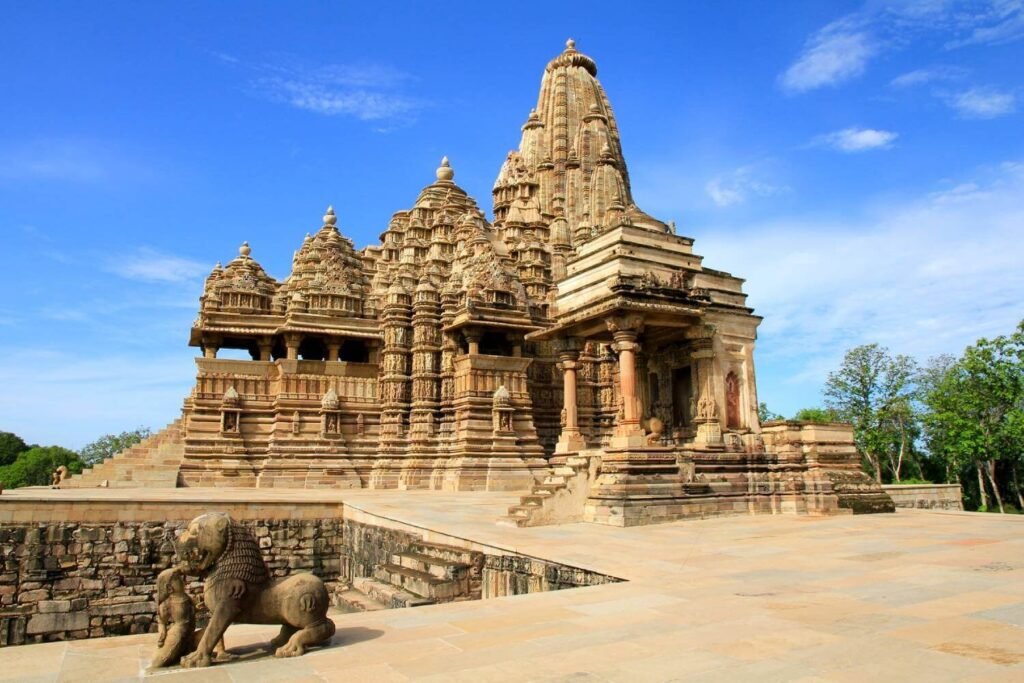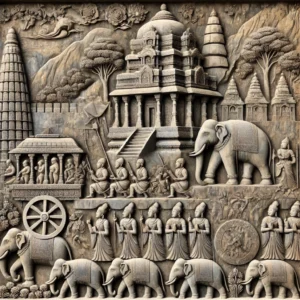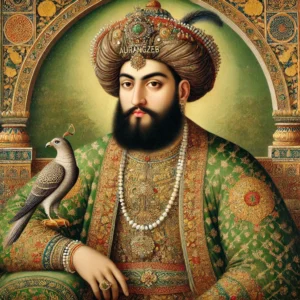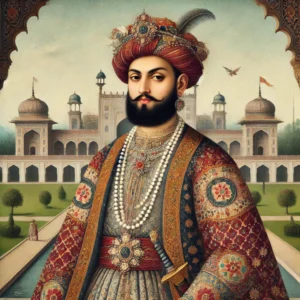
The Majestic Temples of Khajuraho
Nestled in the heart of Madhya Pradesh, the Khajuraho Group of Monuments stands as a testament to the rich cultural and artistic heritage of ancient India. Renowned for their exquisite temple architecture and intricate stone carvings, the temples of Khajuraho were built between 950 and 1050 AD under the rule of the Chandela dynasty. These temples, designated as a UNESCO World Heritage site, are celebrated not only for their religious significance but also for their artistic expression, particularly the erotic sculptures that have intrigued and fascinated scholars and visitors alike. Khajuraho’s temples are a unique blend of spirituality, art, and history, reflecting the complex cultural dynamics of the time.
Historical Background
The history of Khajuraho is closely intertwined with the rise of the Chandela dynasty, which ruled over central India between the 9th and 13th centuries. The Chandelas were known for their patronage of art, architecture, and religion, and they commissioned the construction of numerous temples across their kingdom. The temples at Khajuraho were built during the zenith of the Chandela reign, specifically under the rulers Yashovarman (who ruled around 925–950 AD) and Dhanga (who ruled around 950–1002 AD). These rulers were devout followers of Hinduism and Jainism, and their religious devotion is reflected in the temples they constructed.
Khajuraho was not just a religious center but also a thriving city during this period, although it was not the capital of the Chandela kingdom. The temples were built over a span of approximately 100 years, with each successive ruler contributing to the architectural grandeur of the site. Of the original 85 temples, only 22 have survived the ravages of time. These remaining temples provide a glimpse into the grandeur and spiritual life of the period, showcasing the Chandela dynasty’s deep connection to religious and cultural traditions.
The temples of Khajuraho fell into decline after the fall of the Chandela dynasty, as the region came under the control of various other rulers and empires. Over time, the temples were abandoned and fell into disrepair, becoming obscured by dense forest. It was only in the 19th century, during British colonial rule, that these magnificent structures were rediscovered and brought to the attention of the world. Today, Khajuraho is recognized globally as a symbol of India’s rich cultural and architectural legacy.
Architectural and Artistic Marvels

The Khajuraho temples are celebrated for their stunning architecture and detailed stonework. These temples are a fine example of the Nagara-style architecture, characterized by a distinctively raised platform, intricately carved exteriors, and a complex plan that includes a sanctum (garbhagriha), a hall (mandapa), and often an entrance porch (ardhamandapa).
- Temple Layout: Each temple is built on a high stone platform, with steps leading up to the entrance. The temples are generally aligned from east to west, with the entrance facing the rising sun. This alignment is symbolic, representing the transition from the temporal to the spiritual world.
- Ornamentation and Sculptures: The walls of these temples are adorned with an array of sculptures depicting various aspects of life, mythology, and spirituality. The most famous among these are the erotic sculptures, which occupy a prominent place in Khajuraho’s artistic narrative. These sculptures, however, constitute only a small fraction of the total carvings, with the majority depicting gods, goddesses, mythical creatures, and scenes of everyday life. The erotic figures are often interpreted as symbols of the complex relationship between the earthly and the divine, embodying the Tantric belief in the union of opposites.
- Symbolism: The sculptures and architectural elements of the Khajuraho temples are rich in symbolism. The depiction of celestial beings, apsaras (heavenly nymphs), and mythological scenes reflect the spiritual aspirations of the era. The temples themselves are seen as representations of Mount Meru, the mythological center of the universe in Hindu cosmology, with the central tower (shikhara) symbolizing the ascent to the heavens.
Major Temples of Khajuraho
The temples of Khajuraho are divided into three groups: the Western, Eastern, and Southern groups. Each group contains temples dedicated to various deities of Hinduism and Jainism.
Western Group
Kandariya Mahadeva Temple
- Description: The largest and most ornate temple at Khajuraho, Kandariya Mahadeva is dedicated to Lord Shiva. It is a magnificent example of medieval Indian architecture, with its towering shikhara rising to a height of 31 meters.
- Architectural Highlights: The temple is covered with over 800 sculptures, including deities, apsaras, and erotic figures. The central hall and the sanctum are intricately carved, showcasing the height of artistic excellence.
Lakshmana Temple
- Description: Built by King Yashovarman, the Lakshmana Temple is one of the oldest and most well-preserved temples at Khajuraho. It is dedicated to Lord Vishnu and features a classic five-part design with a sanctum, vestibule, main hall, entrance porch, and a large platform.
- Notable Features: The temple is famous for its detailed friezes and sculptures that narrate stories from Hindu mythology. The central figure of Vishnu, depicted in his Vaikuntha form with three faces, is the main deity of worship.
Vishvanatha Temple
- Description: Dedicated to Lord Shiva, the Vishvanatha Temple is known for its stunning architectural proportions and elaborate sculptures.
- Unique Aspects: The temple is noted for its beautifully carved Nandi (bull) statue in the mandapa, which is considered the mount of Lord Shiva. The external walls are adorned with a plethora of deities and celestial beings.
Chitragupta Temple
- Description: This temple is dedicated to Surya, the Sun God, and is one of the few Sun temples in India. The temple features a large image of Surya driving a chariot pulled by seven horses.
- Architectural Elements: The temple’s carvings include scenes of royal processions, hunting, and various other aspects of life, showcasing the diverse artistic themes at Khajuraho.
Devi Jagadambi Temple
- Description: Initially dedicated to Lord Vishnu, this temple later became associated with the Goddess Parvati or Jagadambi. It is renowned for its beautiful sculptures and a highly decorated sanctum.
- Sculptural Excellence: The temple is filled with detailed carvings, including many erotic figures, making it one of the more prominently decorated temples in the complex.
Chausath Yogini Temple
- Description: This temple is one of the oldest at Khajuraho, dedicated to the 64 yoginis, who are considered manifestations of the Goddess Shakti. Unlike other temples, it is constructed from coarse granite rather than sandstone.
- Historical Significance: The temple has a unique plan with 64 small cells arranged in a circular pattern, which is different from the typical temple architecture of Khajuraho.
Eastern Group
Parsvanatha Temple
- Description: The largest Jain temple at Khajuraho, Parsvanatha Temple is dedicated to the Jain Tirthankara Parsvanatha. It is part of the Eastern group and is noted for its intricate sculptures.
- Architectural Detail: The temple features beautifully carved images of Yakshis and other deities, as well as several figures depicting everyday life. The sanctum houses an image of Parsvanatha.
Adinatha Temple
- Description: This temple is dedicated to Adinatha, the first Jain Tirthankara, and is known for its finely detailed sculptures.
- Key Features: The temple’s outer walls are adorned with carvings of apsaras and other figures, which are similar in style to those found in the Hindu temples of Khajuraho.
Ghantai Temple
- Description: A partially ruined Jain temple, the Ghantai Temple is named after the chain-and-bell motifs carved on its pillars.
- Noteworthy Elements: Despite its ruined state, the temple’s intricate carvings, especially the representation of the 16 dreams of Mahavira’s mother, are of significant artistic value.
Brahma Temple
- Description: This temple is one of the few surviving early temples at Khajuraho and is dedicated to Lord Vishnu, although it is commonly misattributed to Brahma due to an image inside.
- Architectural Simplicity: Unlike the more ornate temples, Brahma Temple is relatively simple, with a square plan and a pyramidal roof, reflecting an earlier style of temple architecture.
Vamana Temple
- Description: Dedicated to Vamana, an incarnation of Vishnu, this temple is a fine example of the classical Nagara style.
- Architectural Highlights: The temple’s outer walls are richly carved with images of deities, apsaras, and various scenes from daily life, showcasing the artistic diversity of the Khajuraho sculptures.
Southern Group
Duladeo Temple
- Description: The Duladeo Temple is one of the later temples built at Khajuraho, dedicated to Lord Shiva. It is known for its delicate carvings and more elaborate erotic sculptures.
- Artistic Features: The temple is richly decorated with images of apsaras, and its shikhara is intricately carved, although it lacks the grandeur of the earlier temples.
Chaturbhuj Temple
- Description: This temple is unique among the Khajuraho temples as it is the only one without erotic sculptures. It is dedicated to Lord Vishnu, who is depicted with four arms (Chaturbhuj).
- Architectural Significance: The temple features a large, majestic statue of Vishnu in the sanctum, and its design reflects the classical style with a simple yet powerful architectural form.
Cultural and Religious Significance
The temples of Khajuraho are more than just architectural marvels; they are deeply embedded in the cultural and religious fabric of the region. During the Chandela period, these temples served as important centers for religious activities, attracting pilgrims from across the country. The temples are dedicated to both Hindu and Jain deities, reflecting the religious diversity and tolerance of the time.

The erotic sculptures, which are often the focal point of discussions about Khajuraho, have various interpretations. Some scholars believe they represent the celebration of life and the joy of existence, while others view them as symbolic of Tantric practices that emphasize the unity of the physical and the spiritual.

Even today, the temples remain active sites of worship, particularly during major Hindu festivals. The Khajuraho Dance Festival, held annually, is a cultural event that showcases classical Indian dance forms against the backdrop of these ancient temples, highlighting their ongoing cultural significance.
Preservation and Tourism
Preservation of the Khajuraho temples has been a priority, especially after their rediscovery in the 19th century. The Archaeological Survey of India (ASI) has undertaken several conservation efforts to protect these monuments from environmental damage and the impact of tourism. However, challenges remain, particularly in balancing the influx of tourists with the need to preserve the delicate carvings and structures.
Tourism has transformed Khajuraho into a major attraction, drawing visitors from around the world. The site is well-maintained, with facilities for tourists including guided tours, informational plaques, and a museum that houses artifacts and information about the site’s history and architecture.
For visitors, it is recommended to explore the temples in all three groups to fully appreciate the diversity and richness of the art and architecture at Khajuraho. The best time to visit is during the cooler months, from October to March, when the weather is pleasant, and the annual dance festival adds a cultural dimension to the experience.
Khajuraho: A UNESCO World Heritage site
The Khajuraho Group of Monuments stands as a remarkable testament to the artistic and architectural achievements of ancient India. These temples, with their intricate carvings and symbolic sculptures, offer a glimpse into the religious and cultural life of the Chandela period. Beyond their historical significance, the temples of Khajuraho continue to inspire awe and admiration for their artistic beauty and spiritual depth. As a UNESCO World Heritage site, Khajuraho remains a cherished symbol of India’s rich cultural heritage, attracting visitors and scholars alike to explore its timeless legacy of art and spirituality. As these ancient stones continue to tell their stories, they invite us to explore the depths of human creativity and the divine aspirations that have shaped our history.





